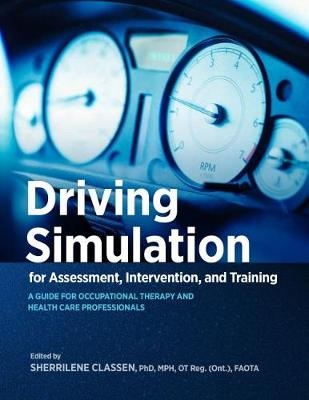
Driving Simulation for Assessment, Intervention, and Training
A Guide for Occupational Therapy and Health Care Professionals
Seiten
2017
American Occupational Therapy (Verlag)
978-1-56900-389-3 (ISBN)
American Occupational Therapy (Verlag)
978-1-56900-389-3 (ISBN)
Driving simulators can detect driving impairments for medically at-risk drivers of all ages and assist in functional rehabilitation. This comprehensive new work provides extensive knowledge, practical guidance, and current evidence on the appropriate use of simulators.
Chapters highlight driving performance issues, assessed via driving simulators, for clients with disabilities across the lifespan and how certain conditions adversely affect driving performance.
Highlights Include—
Part I. Nature and the Scope of Driving Simulation for Health Care Professionals—3 chapters discuss a taxonomy and an overview and history.
Part II. The Developer–Practitioner Relationship—2 chapters describe how to choose and install a simulator and how to introduce simulators to the clinical and scientific communities.
Part III. Fidelity—5 chapters explore physical fidelity and programming, emotional fidelity and reporting, realistic driving simulator scenarios, fidelity test, and validity and reliability issues.
Part IV. Using Driving Simulators in Clinical Settings—4 chapters discuss simulator adaptation syndrome; driving simulation as a tool for best practices, training, and intervention; and simulator maintenance and updating.
Part V. Driving Simulation for Teens and People With Neurological Conditions or Physical Disabilities—7 chapters discus driving performance and simulator use for healthy teens; teens with developmental disorders; people with epilepsy; returning combat veterans; people with dementia; and people with Parkinson’s disease, stroke, or MS.
Part VI. Vehicle Automation and Driving Simulation—1 chapter describes invehicle technology and driving simulation.
Part VII. Documentation and Risk Management—3 chapters discuss report writing and reimbursement, risk management, and ethics.
This first book of its kind explains the cutting-edge role of technological applications of vehicle automation and application during driving simulation. Seasoned practitioners share the strategies for effective documentation to optimize reimbursement, risk management, and ethical practice to equip this generation of health care professionals—who are boldly embracing driving technology in their practices—in a rigorous and sound way. A flash drive contains videos of driving simulations.
Chapters highlight driving performance issues, assessed via driving simulators, for clients with disabilities across the lifespan and how certain conditions adversely affect driving performance.
Highlights Include—
Part I. Nature and the Scope of Driving Simulation for Health Care Professionals—3 chapters discuss a taxonomy and an overview and history.
Part II. The Developer–Practitioner Relationship—2 chapters describe how to choose and install a simulator and how to introduce simulators to the clinical and scientific communities.
Part III. Fidelity—5 chapters explore physical fidelity and programming, emotional fidelity and reporting, realistic driving simulator scenarios, fidelity test, and validity and reliability issues.
Part IV. Using Driving Simulators in Clinical Settings—4 chapters discuss simulator adaptation syndrome; driving simulation as a tool for best practices, training, and intervention; and simulator maintenance and updating.
Part V. Driving Simulation for Teens and People With Neurological Conditions or Physical Disabilities—7 chapters discus driving performance and simulator use for healthy teens; teens with developmental disorders; people with epilepsy; returning combat veterans; people with dementia; and people with Parkinson’s disease, stroke, or MS.
Part VI. Vehicle Automation and Driving Simulation—1 chapter describes invehicle technology and driving simulation.
Part VII. Documentation and Risk Management—3 chapters discuss report writing and reimbursement, risk management, and ethics.
This first book of its kind explains the cutting-edge role of technological applications of vehicle automation and application during driving simulation. Seasoned practitioners share the strategies for effective documentation to optimize reimbursement, risk management, and ethical practice to equip this generation of health care professionals—who are boldly embracing driving technology in their practices—in a rigorous and sound way. A flash drive contains videos of driving simulations.
| Erscheinungsdatum | 28.09.2017 |
|---|---|
| Verlagsort | Maryland |
| Sprache | englisch |
| Maße | 152 x 229 mm |
| Gewicht | 1060 g |
| Themenwelt | Medizin / Pharmazie ► Physiotherapie / Ergotherapie ► Ergotherapie |
| ISBN-10 | 1-56900-389-0 / 1569003890 |
| ISBN-13 | 978-1-56900-389-3 / 9781569003893 |
| Zustand | Neuware |
| Informationen gemäß Produktsicherheitsverordnung (GPSR) | |
| Haben Sie eine Frage zum Produkt? |
Mehr entdecken
aus dem Bereich
aus dem Bereich
Buch | Softcover (2024)
modernes lernen (Verlag)
26,95 €
Buch | Softcover (2023)
modernes lernen (Verlag)
23,95 €


